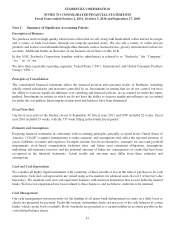Starbucks 2011 Annual Report Download - page 45
Download and view the complete annual report
Please find page 45 of the 2011 Starbucks annual report below. You can navigate through the pages in the report by either clicking on the pages listed below, or by using the keyword search tool below to find specific information within the annual report.We consider financial reporting and disclosure practices and accounting policies quarterly to ensure that they
provide accurate and transparent information relative to the current economic and business environment. We believe
that of our significant accounting policies, the following policies involve a higher degree of judgment and/or
complexity:
Asset Impairment
When facts and circumstances indicate that the carrying values of long-lived assets may not be recoverable, we
evaluate long-lived assets for impairment. We first compare the carrying value of the asset to the asset’s estimated
future undiscounted cash flows. If the estimated future cash flows are less than the carrying value of the asset, we
measure an impairment loss based on the asset’s estimated fair value. For retail assets, the impairment test is
performed at the individual store asset group level. The fair value of a store’s assets is estimated using a discounted
cash flow model based on internal projections. Key assumptions used in this calculation include revenue growth,
operating expenses and a discount rate that we believe a buyer would assume when determining a purchase price for
the store. Estimates of revenue growth and operating expenses are based on internal projections and consider a
store’s historical performance, local market economics and the business environment impacting the store’s
performance. These estimates are subjective and can be significantly impacted by changes in the business or
economic conditions. For non-retail assets, fair value is determined using an approach that is appropriate based on
the relevant facts and circumstances, which may include discounted cash flows, comparable transactions, or
comparable company analyses.
Our impairment loss calculations contain uncertainties because they require management to make assumptions and
to apply judgment to estimate future cash flows and asset fair values, including forecasting asset useful lives.
Further, our ability to realize undiscounted cash flows in excess of the carrying values of our assets is affected by
factors such as the ongoing maintenance and improvement of the assets, changes in economic conditions, and
changes in operating performance. During the past three fiscal years, we have not made any material changes in the
accounting methodology that we use to assess long-lived asset impairment loss. For the foreseeable future, we do
not believe there is a reasonable likelihood that there will be a material change in the estimates or assumptions that
we use to calculate long-lived asset impairment losses. However, as we periodically reassess estimated future cash
flows and asset fair values, changes in our estimates and assumptions may cause us to realize material impairment
charges in the future.
Goodwill Impairment
We test goodwill for impairment on an annual basis during our third fiscal quarter, or more frequently if
circumstances, such as material deterioration in performance or a significant number of store closures, indicate
reporting unit carrying values may exceed their fair values. If the carrying amount of goodwill exceeds the implied
estimated fair value, an impairment charge is recorded to reduce the carrying value to the implied estimated fair
value. The fair value of our reporting units is the price a willing buyer would pay for the reporting unit and is
typically calculated using a discounted cash flow model. Key assumptions used in this calculation include revenue
growth, operating expenses and discount rate that we believe a buyer would assume when determining a purchase
price for the reporting unit. Estimates of revenue growth and operating expenses are based on internal projections
considering a reporting unit’s past performance and forecasted growth, local market economics and the local
business environment impacting the reporting unit’s performance. The discount rate is calculated using an estimated
cost of capital for a retail operator to operate the reporting unit in the region. These estimates are highly subjective
judgments and can be significantly impacted by changes in the business or economic conditions.
Our impairment loss calculations contain uncertainties because they require management to make assumptions and
to apply judgment to estimate the fair value of our reporting units, including estimating future cash flows, and if
necessary, the fair value of a reporting units’ assets and liabilities. Further, our ability to realize the future cash flows
used in our fair value calculations is affected by factors such as changes in economic conditions, changes in our
operating performance, and changes in our business strategies.
39
























